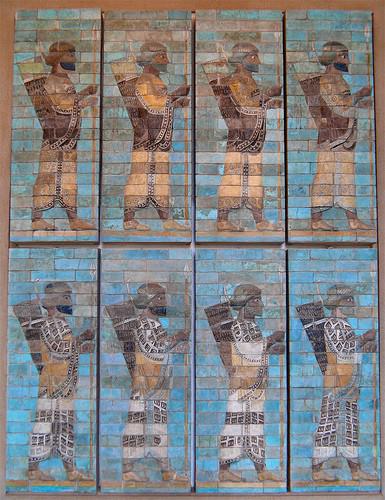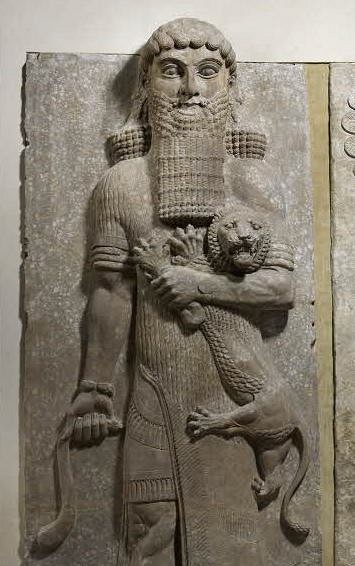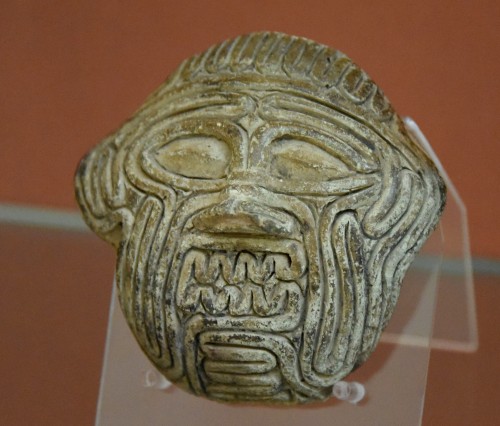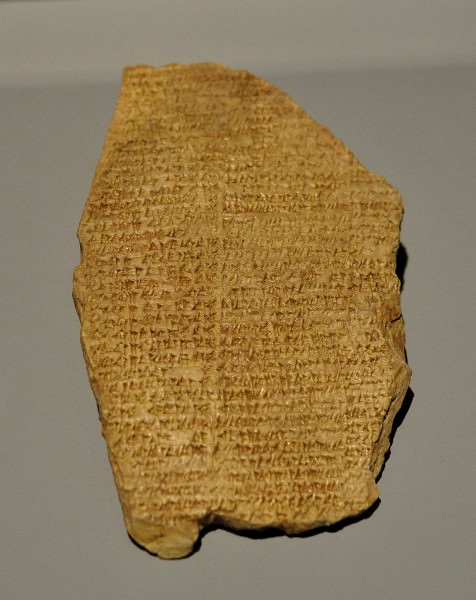Persepolis › Gilgamesh » Ancient origins
Articles and Definitions › Contents
- Persepolis › Antique Origins
- Gilgamesh › Who Was
Ancient civilizations › Historical and archaeological sites
Persepolis › Antique Origins
Definition and Origins

Persepolis is the Greek name (from perses polis for 'Persian City ') for the ancient city of Parsa, located seventy miles northeast of Shiraz in present-day Iran. The name Parsa meant 'City of The Persians' and construction began at the site in 518 BCE under the rule of King Darius the Great (who reigned 522-486 BCE). Darius made Parsa the new capital of the Persian Empire, instead of Pasargadae, the old capital and burial place of King Cyrus the Great. Because of its remote location in the mountains, however, travel to Parsa was almost impossible during the rainy season of the Persian winter when paths turned to mud and so the city was used mainly in the spring and summer warmer seasons. Administration of the Achaemenian Empire was overseen from Susa, from Babylon or from Ecbatana during the cold seasons and it was most likely for this reason that the Greeks never knew of Parsa until it was sacked and looted by Alexander the Great in 330 BCE (the historian Plutarch claiming that Alexander carried away the treasures of Parsa on the backs of 20,000 mules and 5,000 camels).
Though building began under Darius, the glory of Parsa which Alexander found when he invaded was due mainly to the latter works of Xerxes I and Artaxerxes III, both of whose names have been found (besides that of Darius) inscribed on tablets, over doorways and in hallways throughout the ruins of the city.
Though building began under Darius, the glory of Parsa which Alexander found when he invaded was due mainly to the latter works of Xerxes I and Artaxerxes III, both of whose names have been found (besides that of Darius) inscribed on tablets, over doorways and in hallways throughout the ruins of the city.
THE GREAT CITY OF PERSEPOLIS WAS BUILT IN TERRACES UP FROM THE RIVER PULWAR TO RISE ON A LARGER TERRACE OF OVER 125,000 SQUARE FEET.
The great city of Persepolis was built in terraces up from the river Pulwar to rise on a larger terrace of over 125,000 square feet, partly cut out of the Mountain Kuh-e Rahmet ("the Mountain of Mercy"). To create the level terrace, large depressions were filled with soil and heavy rocks which were then fastened together with metal clips; upon this ground the first palace at Persepolis slowly grew. Around 515 BCE, construction of a broad stairway was begun up to the palace doors. This grand, dual entrance to the palace, known as the Persepolitan stairway, was a masterpiece of symmetry on the western side of the building and the steps were so wide that Persian royalty and those of noble birth could ascend or descend the stairs by horseback, thereby not having to touch the ground with their feet. The top of the stairways led to a small yard in the north-eastern side of the terrace, opposite the Gate of all Nations.
The great palace built by Xerxes I consisted of a grand hall that was eighty-two feet in length, with four large columns, the entrance on the Western Wall. Here the nations which were subject to the Empire gave their tribute to the king. There were two doors, one to the south which opened to the Apadana yard and the other opening onto a winding road to the east. Pivoting devices found on the inner corners of all the doors indicate that they were two-leafed doors, probably made of wood and covered with sheets of ornate metal. Off the Apadana yard, near the Gates of all Nations, was Darius' great Apadana Hall, where he would receive dignitaries and guests which, by all accounts, was a place of stunning beauty (thirteen of the pillars of the Hall still stand today and remain very impressive).
Limestone was the main building material used in Persepolis. After natural rock had been leveled and the depressions filled in, tunnels for sewage were dug underground through the rock. A large elevated cistern was carved at the eastern foot of the mountain to catch rain water for drinking and bathing.
The great palace built by Xerxes I consisted of a grand hall that was eighty-two feet in length, with four large columns, the entrance on the Western Wall. Here the nations which were subject to the Empire gave their tribute to the king. There were two doors, one to the south which opened to the Apadana yard and the other opening onto a winding road to the east. Pivoting devices found on the inner corners of all the doors indicate that they were two-leafed doors, probably made of wood and covered with sheets of ornate metal. Off the Apadana yard, near the Gates of all Nations, was Darius' great Apadana Hall, where he would receive dignitaries and guests which, by all accounts, was a place of stunning beauty (thirteen of the pillars of the Hall still stand today and remain very impressive).
Limestone was the main building material used in Persepolis. After natural rock had been leveled and the depressions filled in, tunnels for sewage were dug underground through the rock. A large elevated cistern was carved at the eastern foot of the mountain to catch rain water for drinking and bathing.

Ranks of Immortals
“Alexander held games in honor of his victories. He performed costly sacrifices to the gods and entertained his friends bountifully. While they were feasting and the drinking was far advanced, as they began to be drunken, a madness took possession of the minds of the intoxicated guests. At this point one of the women present, Thais by name and Athenian by origin, said that for Alexander it would be the finest of all his feats in Asia if he joined them in a triumphal procession, set fire to the palaces, and permitted women's hands in a minute to extinguish the famed accomplishments of the Persians. This was said to men who were still young and giddy with wine, and so, as would be expected, someone shouted out to form up and to light torches, and urged all to take vengeance for the destruction of the Greek temples [burned by the Persians when they invaded Athens in 480 BCE]. Others took up the cry and said that this was a deed worthy of Alexander alone. When the king had caught fire at their words, all leaped up from their couches and passed the word along to form a victory procession in honor of the god Dionysus. Promptly many torches were gathered. Female musicians were present at the banquet, so the king led them all out to the sound of voices and flutes and pipes, Thais the courtesan leading the whole performance. She was the first, after the king, to hurl her blazing torch into the palace. As the others all did the same, immediately the entire palace area was consumed, so great was the conflagration. It was most remarkable that the impious act of Xerxes, king of the Persians, against the acropolis at Athens should have been repaid in kind after many years by one woman, a citizen of the land which had suffered it, and in sport.”
The fire, which consumed Persepolis so completely that only the columns, stairways and doorways remained of the great palace, also destroyed the great religious works of the Persians written on “prepared cow-skins in gold ink” as well as their works of art. The palace of Xerxes, who had planned and executed the invasion of Greece in 480, received especially brutal treatment in the destruction of the complex. The city lay crushed under the weight of its own ruin (although, for a time, nominally still the capital of the now-defeated Empire) and was lost to time. It became known to residents of the area only as 'the place of the forty columns'(for the still-remaining columns standing among the wreckage) until, in 1618 CE, the site was identified as Persepolis. In 1931 excavations were begun which revealed the glory which had once been Persepolis.
MAP
Gilgamesh › Who Was
Definition and Origins

Gilgamesh is the semi-mythic King of Uruk in Mesopotamia best known from The Epic of Gilgamesh (written c. 2150 - 1400 BCE) the great Sumerian/Babylonian poetic work which pre-dates Homer ’s writing by 1500 years and, therefore, stands as the oldest piece of epic world literature.
The motif of the quest for the meaning of life is first fully explored in Gilgamesh as the hero-king leaves his kingdom following the death of his best friend, Enkidu, to find the mystical figure Utnapishtim and gain eternal life. Gilgamesh's fear of death is actually a fear of meaninglessness and, although he fails to win immortality, the quest itself gives his life meaning. This theme has been explored by writers and philosophers from antiquity up to the present day.
HISTORICAL & LEGENDARY KING
Gilgamesh's father is said to have been the Priest-King Lugalbanda (who is featured in two Sumerian poems concerning his magical abilities which pre-date Gilgamesh ) and his mother the goddess Ninsun (also known as Ninsumun, the Holy Mother and Great Queen). Accordingly, Gilgamesh was a demi-god who was said to have lived an exceptionally long life (the Sumerian King List records his reign as 126 years) and to be possessed of super-human strength.
Known as 'Bilgames' in the Sumerian, 'Gilgamos' in Greek, and associated closely with the figure of Dumuzi from the Sumerian poem The Descent of Inanna, Gilgamesh is widely accepted as the historical 5th king of Uruk who reigned in the 26th century BCE. His influence was so profound that myths of his divine status grew up around his deeds and finally culminated in the tales found in The Epic of Gilgamesh. Later Mesopotamian kings would invoke his name and associate his lineage with their own. Most famously, Shulgi of Ur (2029-1982 BCE), considered the greatest king of the Ur III Period (2047-1750 BCE) in Mesopotamia, claimed Lugalbanda and Ninsun as his parents and Gilgamesh as his brother to elevate his reign in the eyes of the people.
Known as 'Bilgames' in the Sumerian, 'Gilgamos' in Greek, and associated closely with the figure of Dumuzi from the Sumerian poem The Descent of Inanna, Gilgamesh is widely accepted as the historical 5th king of Uruk who reigned in the 26th century BCE. His influence was so profound that myths of his divine status grew up around his deeds and finally culminated in the tales found in The Epic of Gilgamesh. Later Mesopotamian kings would invoke his name and associate his lineage with their own. Most famously, Shulgi of Ur (2029-1982 BCE), considered the greatest king of the Ur III Period (2047-1750 BCE) in Mesopotamia, claimed Lugalbanda and Ninsun as his parents and Gilgamesh as his brother to elevate his reign in the eyes of the people.

Map of Sumer
DEVELOPMENT OF THE TEXT
The Akkadian version of the text was discovered at Nineveh, in the ruins of the library of Ashurbanipal, in 1849 CE by the archaeologist Austin Henry Layard. Layard's expedition was part of a mid-19th century CE initiative of European institutions and governments to fund expeditions to Mesopotamia to find physical evidence to corroborate events described in the Bible.What these explorers found instead, however, was that the Bible - previously thought to be the oldest book in the world and comprised of original stories - actually drew upon much older Sumerian myths.
The Epic of Gilgamesh did likewise as it is a compilation of tales, no doubt originally passed down orally, which was finally written down 700-1000 years after the historical king's reign. The author of the version Layard found was the Babylonian writer Shin-Leqi-Unninni (wrote 1300-1000 BCE) who was thought to be the world's first author known by name until the discovery of the works of Enheduanna (2285-2250 BCE), daughter of Sargon of Akkad. Shin-Leqi-Unninni drew upon Sumerian sources to create his story and probably had a significant number to work from as Gilgamesh had been a popular hero for centuries by the time the epic was created.
GILGAMESH RESCUES A POWERFUL & POTENT GODDESS FROM A DIFFICULT SITUATION WHICH SHOWS THE HIGH REGARD IN WHICH HE WAS HELD.
In the Sumerian tale of Inanna and the Huluppu Tree, in which the goddess Inanna plants a troublesome tree in her garden and appeals to her family for help with it, Gilgamesh appears as her loyal brother who comes to her aid.
In this story, Inanna (the Sumerian goddess of love and war ) plants a tree in her garden with the hope of one day making a chair and bed from it. The tree becomes infested, however, by a snake at its roots, a female demon ( lilitu) in its center, and an Anzu bird in its branches.
No matter what, Inanna cannot rid herself of the pests and so appeals to her brother, Utu, god of the sun, for help. Utu refuses but her plea is heard by Gilgamesh who comes, heavily armed, and kills the snake. The demon and Anzu bird then flee and Gilgamesh, after taking the branches for himself, presents the trunk to Inanna to build her bed and chair from. This is thought to be the first appearance of Gilgamesh in heroic poetry and the fact that he rescues a powerful and potent goddess from a difficult situation shows the high regard in which he was held even early on.
Other tales mentioning Gilgamesh also represent him as the great hero and the historical king was eventually accorded completely divine status as a god. He was seen as the brother of Inanna, one of the most popular goddesses, if not the most popular, in all of Mesopotamia. Prayers found inscribed on clay tablets address Gilgamesh in the afterlife as a judge in the Underworld comparable in wisdom to the famous Greek judges of the Underworld, Rhadamanthus, Minos, and Aeacus.

Face of the Demon Humbaba
THE EPIC TALE
In The Epic of Gilgamesh, the great king is thought to be too proud and arrogant by the gods and so they decide to teach him a lesson by sending the wild man, Enkidu, to humble him. Enkidu and Gilgamesh, after a fierce battle in which neither are bested, become friends and embark on adventures together.
They kill Humbaba, demon of the Cedar Forest, and this attracts the attention of Inanna (known by her Akkadian/Babylonian name Ishtar in the story). Inanna tries to seduce Gilgamesh but he rejects her, citing all the other men she has had as lovers who ended their lives poorly. Inanna is enraged and sends her brother-in-law, the Bull of Heaven, down to earth to destroy Gilgamesh. Enkidu comes to his friend's aid and kills the bull but, in doing so, he has offended the gods and is condemned to death.
When Enkidu dies, Gilgamesh falls into a deep grief and, recognizing his own mortality through the death of his friend, questions the meaning of life and the value of human accomplishment in the face of ultimate extinction. He cries:
How can I rest, how can I be at peace? Despair is in my heart. What my brother is now, that shall I be when I am dead. Because I am afraid of death I will go as best I can to find Utnapishtim whom they call the Faraway, for he has entered the assembly of the gods. (Sandars, 97)
Casting away all of his old vanity and pride, Gilgamesh sets out on a quest to find the meaning of life and, finally, some way of defeating death. He travels through the mountains, over vast oceans, and finally locates Utnapishtim who offers him two chances at immortality; both of which he fails. First, he cannot remain awake for six days and six nights and, second, he fails to protect a magic plant; a snake eats the plant while Gilgamesh sleeps. Failing to have won immortality, he is rowed back home by the ferryman Urshanabi and, once there, writes down his story.
LEGACY & CONTINUING DEBATE
Through his struggle to find meaning in life, Gilgamesh defied death and, in doing so, becomes the first epic hero in world literature. The grief of Gilgamesh, and the questions his friend's death evoke, resonate with every human being who has wrestled with the meaning of life in the face of death. Although Gilgamesh ultimately fails to win immortality in the story, his deeds live on through the written word and, so, does he.

The Story of Gilgamesh and Aga
Since The Epic of Gilgamesh existed in oral form long before it was written down, there has been much debate over whether the extant tale is more early Sumerian or later Babylonian in cultural influence. The best-preserved version of the story, as noted, comes from Shin-Leqi-Unninni who most likely embellished on the original Sumerian source material. Regarding this, the Orientalist Samuel Noah Kramer writes:
Of the various episodes comprising The Epic of Gilgamesh, several go back to Sumerian prototypes actually involving the hero Gilgamesh. Even in those episodes which lack Sumerian counterparts, most of the individual motifs reflect Sumerian mythic and epic sources. In no case, however, did the Babylonian poets slavishly copy the Sumerian material. They so modified its content and molded its form, in accordance with their own temper and heritage, that only the bare nucleus of the Sumerian original remains recognizable. As for the plot structure of the epic as a whole - the forceful and fateful episodic drama of the restless, adventurous hero and his inevitable disillusionment - it is definitely a Babylonian, rather than a Sumerian, development and achievement.(History Begins at Sumer, 270).
Historical evidence for Gilgamesh's existence is found in inscriptions crediting him with the building of the great walls of Uruk (modern day Warka, Iraq) which, in the story, are the tablets upon which he first records his great deeds and his quest for the meaning of life. There are other references to him by known historical figures of his time such as King Enmebaragesi of Kish and, of course, the Sumerian King List and the legends which grew up around his reign.
A GERMAN TEAM OF ARCHAEOLOGISTS CLAIM TO HAVE DISCOVERED THE TOMB OF GILGAMESH IN APRIL OF 2003 CE.
In the present day, Gilgamesh is still spoken of and written about. A German team of Archaeologists claim to have discovered the Tomb of Gilgamesh in April of 2003 CE. Archaeological excavations, conducted through modern technology involving magnetization in and around the old riverbed of the Euphrates, have revealed garden enclosures, specific buildings, and structures described in The Epic of Gilgamesh including the great king's tomb. According to legend, Gilgmesh was buried at the bottom of the Euphrates when the waters parted upon his death.
Whether the historical king existed is no longer relevant, however, as the character has taken on a life of his own over the centuries. At the end of the story, when Gilgamesh lays dying, the narrator says:
The heroes, the wise men, like the new moon have their waxing and waning. Men will say, "Who has ever ruled with might and with power like [Gilgamesh]?" As in the dark month, the month of shadows, so without him there is no light. O Gilgamesh, you were given the kingship, such was your destiny, everlasting life was not your destiny. Because of this, do not be sad at heart, do not be grieved or oppressed; he has given you power to bind and to loose, to be the darkness and the light of mankind. (Sanders, 118)
The story of Gilgamesh's failure to realize his dream of immortality is the very means by which he attains it. The epic itself is immortality and has served as the model for any similar tale which has been written since. It was no doubt widely read prior to the fall of the Assyrian Empire in 612 BCE and has become increasingly popular and influential since its rediscovery in 1879 CE.
Gilgamesh encourages hope in that, even though one may not be able to live forever, the choices one makes in life resonate in the lives of others. These others may be friends, family, acquaintances, or may be strangers living long after one's death who continue to be touched by the eternal story of the hero's refusal to accept a life without meaning. Gilgamesh's struggle against apparent meaninglessness defines him - just as it defines anyone who has ever lived - and his quest continues to inspire those who recognize how eternal and intrinsically human that struggle is.
LICENSE:
Article based on information obtained from these sources:with permission from the Website Ancient History Encyclopedia
Content is available under License Creative Commons: Attribution-NonCommercial-ShareAlike 3.0 Unported. CC-BY-NC-SA License